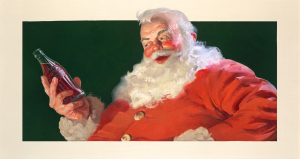HADDON SUNDBLOM: Santa Paintings
EXTENDED THROUGH DECEMBER 21, 2013!
Christmas comes early in the Skylight Gallery! We now have on view a selection of original Santa Paintings by Haddon Sundblom and vintage ad materials. Haddon Sundblom: Santa Paintings presents major paintings by Sundblom (1899-1976) from the 1930s, 40s, 50s and 60s. With Clement Clark Moore’s 1822 poem, A Visit from St. Nicholas, as his inspiration, Sundblom created for The Coca-Cola Company our modern-day concept of Santa as a jolly, plump and hard-working fellow.
Special addition! Enjoy the exhibition and visit with Santa Claus. He and Elf Evie are flying in from the North Pole every Saturday in December to visit with kids! Photography permitted and encouraged. More information.
Exhibition general admission: $5 / free for OUMA members and with a Petrel Pass. Children under 12 are free.
This exhibition is courtesy of
Born in Michigan, Sundblom moved to Chicago at the age of thirteen. Working construction jobs during the day, he took night classes in illustration at the Art Institute of Chicago and the American Academy of Art. Soon after, he began as an apprentice at one of Chicago’s largest illustration firms—the Charles Everett Johnson Studios. By 1925, Sundblom and two colleagues had opened their own firm.
The Coca-Cola Company was one of the firm’s earliest clients; Sundblom created more art for Coca-Cola than any other single artist. From 1931 to 1964, he produced at least one image of Santa Claus annually for Coca-Cola. His work was reproduced on calendars, billboards, posters, cut-outs, and in magazines, ensuring the widespread popularity of his particular conception of Santa, Sundblom’s original model was a neighbor and retired salesman, Lou Prentice. After Prentice died in the 1950’s, Sundblom used himself as a model.
Yet Santa has always been commercial. Santa’s earliest likenesses were created by mass media artists. Initially, these artists produced many different Santas—authoritarian ones, scary ones, and kind ones. Famous illustrators such as Thomas Nast, J. C. Leyendecker, and Norman Rockwell standardized a more consistent image of Santa in the popular press.
These precedents influenced the Santa that Haddon Sundblom created for Coca-Cola in 1931. The company hired Sundblom to paint a figure that would encourage Americans to drink Coke in the winter months. (Until 1931, Coke was considered a summer beverage.) Sundblom produced at least one Santa annually for Coca-Cola through 1964.
Conceived during the Great Depression, Sundblom’s merry, portly Santa changed very little over the years. Poised with a Coke bottle in one hand and a quill pen or handcrafted toy in the other, he seems to strike a reassuring balance between commercial interests and time-honored traditions. Reproduced by the millions, Sundblom’s Santa boosted winter sales and became a holiday archetype that endures in television, films, and department stores today.
Until the nineteenth century, the Christmas season in Europe and North America mimicked Saturnalia. Celebrations were marked by behavior that many would find offensive today: excessive displays of public drinking, eating, gambling, lewdness, mocking of authority, and aggressive begging. This unruly behavior led the Puritans to ban Christmas celebrations for a period of time.
In the nineteenth century, Christmas was transformed from a pagan free-for-all to a quiet domestic ritual centered on children and gift-giving. In Europe, a variety of descendants of St. Nicholas presided over the Christmas season. In the United States, the newly invented Santa Claus figured prominently in this ritual. All told, the Victorians created a much more manageable, predictable holiday that endures with us today.


